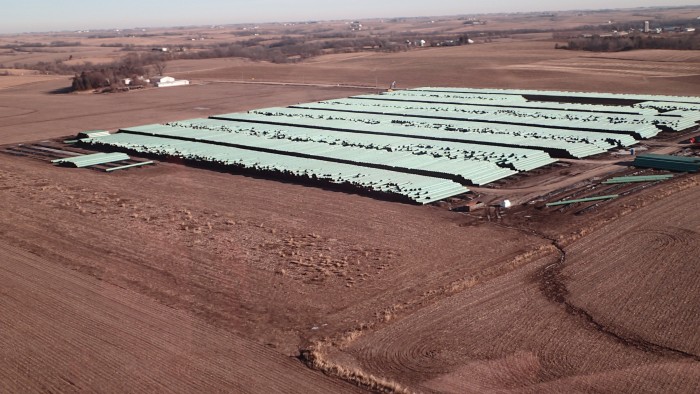The Iowa Department of Natural Resources amended a permit to allow Dakota Access to run the Bakken pipeline under a sensitive area in the Big Sioux River Wildlife Management Area, William Petroski reported for the Des Moines Register on June 20. The amendment means Dakota Access is no longer subject to the stop-work order the DNR imposed last month. DNR spokesperson Kevin Baskins told Petroski the company will run the pipeline “about 85 feet underground” to avoid disrupting sacred ground, which may include American Indian burial sites.
State Archaeologist John Doershuk said in an email last week to DNR Director Chuck Gipp that the proposed directional boring construction method is a satisfactory avoidance procedure from an archaeological standpoint that he supports in this case. However, Doershuk emphasized he could not speak for American Indian tribes that have expressed concerns about the pipeline project.
Energy Transfer Partners, the parent company of Dakota Access, maintains that a 2004 archeological review of the site in question did not turn up any areas of cultural significance. Gavin Aronsen posted that document and comments from a company spokeswoman at Iowa Informer.
Now that the DNR has lifted the stop-work order and the Iowa Utilities Board has changed its stance to allow pipeline construction before Dakota Access has all federal permits in hand, only two legal obstacles stand in the way of completing the project across eighteen Iowa counties. The U.S. Army Corps of Engineers has yet to issue permits covering a small portion of the Iowa route–though I would be shocked to see the federal government stand in the way once construction has begun. A series of landowner lawsuits are challenging the use of eminent domain for the Bakken pipeline, saying a 2006 Iowa law does not allow farmland to be condemned for a private project by a company that is not a utility.
Pipes intended for use in the Dakota Access pipeline being stored in Jasper County, Iowa during 2015. Photo provided by Wallace Taylor, used with permission.


2 Comments
DNR shrugs off its regulatory duties
This is very alarming. First, burying the pipeline 85 feet below ground means that if it ever leaks, there is NO WAY the pipeline operator will ever be able to dig it back up. It also assures that there is a direct injection of oil into the aquifers that Iowans depend upon for their water sources. In its environmental review filed with DNR, Energy Transfer Partners did not indicate that any of its several underground crossings will be equipped with shut off valves that would enable the company to isolate a deeply buried pipe segment in the event of a leak or suspected leak. It is fair to assume that such provision will not be made and that the tremendous risk posed by such leaks is borne solely by the people of Iowa.
Secondly, the horizontal boring technique means the install crews will first drill a horizontal run that is typically 1,000 feet long, or longer. That means the drilling component will generate thousands of cubic feet of drilling spoils, which ETC did not bother to describe how they will be disposed, except to hint that they will be piled on the ground and allowed, by natural processes, to find their way into nearby surface waters. And once the bore hole is complete, the crews will drag the assembled pipeline from the far end or exit of the bore hole back to the entry point. That means 1,000 feet or more of assembled pipe will be subject to all manner of abrasive scraping as the pipe is dragged through bedrock, erratic boulders or other hard, sharp objects buried underground in the bore hole path. The installation crews will have no way of knowing if or how badly scarred the protective wrap on the outside of the pipe could be damaged. And even if they did suspect or know of such damage, they could not repair it. ANY deep scratching, tearing or perforations in the outside skin of the pipeline will ultimately be fatal to it’s integrity years after it is installed.
Thirdly, the legal precedent of allowing a user to usurp tribal claims by burrowing underground fits perfectly with the view held by Texans that fee title means nothing when they wish to use lands that do not belong to them for their own purposes, but does raise troubling questions about whether the tribes really do own their land, and if they do, under what circumstances can others confiscate it for their own purposes. ETC’s use of eminent domain to grab Iowa lands from owners not willing to allow the proposed use is bad enough; to now expand the thievery to include the taking of tribal lands is a sad contribution to the generations of land theft committed against these tribes.
Finally, the DNR’s ruling is very bad public policy, as its initial sovereign lands approval was conditioned upon ETC self-reporting any archaeological, ecological, geological or hydrological field findings that might be of interest to the state or federal authorities. That itself was an abject failure to assert regulatory authority over this project. To now allow construction to proceed without so much as even a hearing on the matter confirms my worst misgivings that the DNR has not taken this matter seriously and is apparently incapable of providing any meaningful oversight for this project.
JohnMorrissey Mon 27 Jun 11:28 AM
you raise many important points
If you would be willing to post this comment (either as is or expanded) as a separate diary by clicking on “write a post” in the upper right corner, I would be happy to move it to the front page.
desmoinesdem Mon 27 Jun 12:24 PM